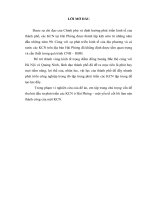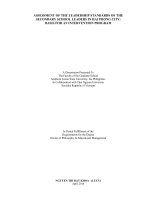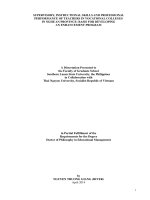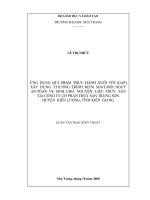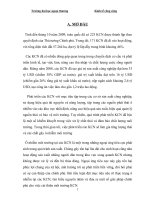Thực trạng phát triển nguồn nhân lực tại khu công nghiệp bắc thăng long và nam thăng long cơ sở xây dựng chương trình phát triển nguồn nhân lực toàn diện cho các khu công nghiệp ở việt nam
Bạn đang xem bản rút gọn của tài liệu. Xem và tải ngay bản đầy đủ của tài liệu tại đây (833.97 KB, 79 trang )
Thai Nguyen University
Socialist Republic of Vietnam
Southern Luzon State University
Republic of Philippines
HUMAN RESOURCE DEVELOPMENT (HRD) PRACTICES IN BAC THANG LONG
AND NAM THANG LONG INDUSTRIAL PARKS: BASES FOR A COMPREHENSIVE
HRD PROGRAM FOR INDUSTRIAL PARKS IN VIETNAM
A Research Proposal
Presented to the Faculty of Graduate School
Southern Luzon State University, The Philippines and
Thai Nguyen University, Socialist Republic of Vietnam
In Partial Fulfillment of
The Requirements for the Degree
Doctor in Business Administration
PHAM HAI HUNG (JO)
August, 2013
APPROVAL SHEET
In partial fulfillment of the requirements for the degree Doctor in Business
Administration, this research entitled :"Human resource development (HRD) practices in
Bac Thang Long and Nam Thang Long industrial Parks: bases for a comprehensive HRD
program for industrial Parks in Vietnam” has been submitted by Pham Hai Hung - Jo, and
is hereby recommended for oral examination.
PROF. CONRADO L. ABRAHAM
Research Adviser
Approved by the Oral Examination Committee, in partial fulfillment of the
requirements for the degree Doctor in Business Administration offered by Southern Luzon
State University, Republic of the Philippines in collaboration with Thai Nguyen University,
Socialist Republic of Vietnam.
Dr………………………..…………………..
Member
Dr………………………..…………………..
Member
Dr………………………..…………………..
Member
Dr………………………..…………………..
Member
Dr………………………..…………………..
Chairman
Accepted in partial fulfillment of the requirements for the degree Master in
Business Administration.
SOUTHERN LUZONG STATE UNIVERSITY
Dean
i
ACKNOWLEDGMENT
In grateful recognition and sincerest thanks for the encouragement, guidance and
unselfish sharing of their knowledge, time, effort and skills, and for the untiring motivation
that leads to the completion of this study, the Researcher acknowledges the following:
The deep thanks to DR. CECILIA N. GASCON, Ph. D. President of the Southern
Luzon State University in the Republic of the Philippines, for her untiring effort and belief
that this collaboration is possible thus enabling us to pursue the DBA degree;
Sincere thanks to DR. NGUYEN THANH HAI, Vice Director of the International
Training Center, Thai Nguyen University of the Socialist Republic of Vietnam who was
always available to help me during the years;
PROF. CONRADO L. ABRAHAM for his selfless guidance and assistance in
helping me to stay on the right track;
ITC staff, for providing the necessary research materials;
Thanks to Managers and Employees of Bac Thang Long and Nam Thang Long
Parks, my Respondents, for their patience and cooperation in answering the questionnaire
and for other data given;
Especial thanks to my Family and Friends, for the love and supports in one way or
the other.
And to all who have contributed to make this study a success.
ii
ABSTRACT
Human Resources Development (HRD) as a theory is activities for the expansion of
human capital within an organization through the development of both the organization and
the individual to achieve performance improvement.
Bac Thang Long and Nam Thang Long industrial parks are two large industrial
Zones in Hanoi with a hundred of companies are operating; the companies in there have
achieved great successes in their business so far. However, the companies are also facing
challenges related to human resources. For that reason the study: "Human resource
development (HRD) practices in Bac Thang Long and Nam Thang Long industrial
Parks: bases for a comprehensive HRD program for industrial Parks in Vietnam” was
conducted.
The study aims to identify aspects of the real situation of human resource
development in Bac Thang Long and Nam Thang Long industrial Parks. The study
answered the questions of What is the profile of the respondents at both industrial Parks in
terms of: Age, Gender, Educational level, Position; What are the human resource
development practices of the foreign companies and Vietnam companies in terms of
Training; Which of the HRD practices were perceived to be acceptable and common
among group of respondents; What HRD program can be developed as bases of
implementing HRD practices in industrial parks.
From analysis, training and development proposal along with a comprehensive
HRD program.
iii
TABLE OF CONTENTS
Page No.
Chapter 1: INTRODUCTION .................................................................................... 1
1.1. Background. ........................................................................................................2
1.2. Statement of the Problem ....................................................................................3
1.3. Objectives of the Research…………………………………………………… 4
1.4. Significances of the Research .............................................................................5
1.5. Scope and Delimitation ......................................................................................5
1.6. Definition of terms ..............................................................................................6
Chapter 2: LITERATURE REVIEW AND RELATED STUDIES ..........................8
2.1. Literature Review................................................................................................8
2.2. Review of Related Studies. ................................................................................20
2.3 Conceptual Framework .......................................................................................22
Chapter 3: RESEARCH METHODOLOGY .............................................................23
3.1. Research Design.................................................................................................23
3.2. Locale of the study .............................................................................................23
3.3. Data collection method ............................................................................................................23
3.4. Population, Sample and Sampling Technique ...................................................24
3.5. Research Instrument...........................................................................................26
3.6. Procedures for conducting the survey ................................................................26
3.7. Statistical Treatment .........................................................................................27
Chapter 4: PRESENTATION, ANALYSIS AND INTERPRETATION
OF DATA ...................................................................................................... 28
4.1. Profiles of respondents ......................................................................................28
4.2. Perceptions on training………………………………………………………….33
4.3. Comprehensive HRD Program .........................................................................50
Chapter 5. SUMMARY, CONCLUSIONS AND RECOMMENDATIONS ...........57
5.1. Summary of Findings .........................................................................................57
5.2. Conclusion ........................................................................................................59
iv
5.3. Recommendation ...............................................................................................60
BIBLIOGRAPHY .........................................................................................................63
QUESTIONNAIRE.......................................................................................................65
RESEARCHER CV ......................................................................................................71
v
LIST OF TABLES
Page No.
Table 2.1. Comparison among training, education and development……………………...9
Table 3.1. Distribution of the respondents .........................................................................24
Table 3.2. Description of the Respondents ........................................................................25
Table 4.1. Trainees of training program ............................................................................37
Table 4.2. Training Needs Assessment .............................................................................39
Table 4.3. Training methods .............................................................................................42
Table 4.4. Training Time ...................................................................................................43
Table 4.5.Training contents for managers .........................................................................45
Table 4.6. Training budget ................................................................................................47
Table 4.7. Criteria of training evaluation ...........................................................................49
Table 4.8. A sample of job description .............................................................................51
Table 4.9. A sample of evaluation test ..............................................................................54
Table 4.10. Summary of comprehensive HRD program ..................................................55
LIST OF FIGURES
Page No.
Figure 2.1. Changing role of training................................................................................ 9
Figure 2.2. The needs assessment process ...................................................................... 14
Figure 2.3. Presents conceptual framework .................................................................... 21
vi
LIST OF CHARTS
Page No.
Chart 4.1. Gender structure of managers group .............................................................. 28
Chart 4.2. Age structure of management group .............................................................. 29
Chart 4.3. Education levels of management group ......................................................... 30
Chart 4.4. Gender structures of employees ..................................................................... 31
Chart 4.5. Age structure of employees............................................................................ 31
Chart 4.6. Education levels of employees ....................................................................... 32
Chart 4.7. Purpose of training program in Vietnam companies ..................................... 33
Chart 4.8. Purpose of training program in foreign companies ........................................ 34
Chart 4.9. Trainees of training program in Vietnam companies..................................... 35
Chart 4.10. Trainees of training program in foreign companies ..................................... 35
Chart 4.11. Training needs assessment in Vietnam companies ...................................... 38
Chart 4.12. Training needs assessment in foreign companies ........................................ 38
Chart 4.13. The training methods in foreign companies ................................................. 40
Chart 4.14. The training methods in Vietnam companies .............................................. 41
Chart 4.15. Training content for employees in foreign companies................................. 44
Chart 4.16. Training content for employees in Vietnam companies .............................. 44
Chart 4.17. The effectiveness of training in Vietnam companies ................................... 48
Chart 4.18. The effectiveness of training in foreign companies ..................................... 49
vii
Chapter 1
INTRODUCTION
To develop an economy that requires the resources: capital, science - technology,
natural resources and manpower; to grow rapidly and sustainably it should be based on
three basic elements: apply new technologies, development of modern infrastructure and
improve the quality of human resources.
The socio-economic development depends on many factors, and conditions, but
most remain largely dependent on human factors, compare with other resources, the human
resource is more dominant. Therefore, more than any other resources, human resource
always occupies the central location and play leading role in socio-economic development
of the country, especially in the promoting period of industrialization modernization and
international economic integration.
The exploitation and utilization of human resource effectively is extremely
important issue, human resource should promote the diversity and abundance of Eastern
cultural traditions such as hospitality, the talent, intellectual, science... However so far, the
important potentials have not been exploited fully, properly and may have not used
effectively.
Today, when the world enters the intellectual economic, the problem of talent is a
critical issue, because talented people are the nucleus of intellectual economy. Although
talented people at any time is always important, but nowadays it is even more important
than ever, To take a short-cut and leader in the development it must have advanced human
resource, not to forget talented people and not to waste human resource. Therefore,
countries should actively plan, create sources, training and retraining of human resources to
1
develop most effectively
For Vietnam, is in the modernization and industrialization process, many industrial
zones and export processing zones have been established and attracted millions of
employees working inside that promoted the country‟s economic growth. However, the
industrial zones are facing some difficulties; one of them regards to human resource,
workforce has not satisfied requirements yet, because of low trained percentage,
Government's report in 2009 said: "The quality of human resources of Vietnam today is
low; the percentage of trained labor reaches only a bout 38%." Therefore, if it would be
trained that will be the resources with strong impact on growth and economic development
of the country.
For company, in the strong competitive environment, many companies have paid
attention to training and human resource development, because human resource is the basis
for existence and development of the company. Through training that can provide skilled
staff for the company to accomplish tasks given and also increase productivity. Moreover,
along with advance in technique – technology requires company has to train a team of hiskilled, hi-tech and creative staff to handle complex problems which they can not do
before. Beside, in market economy, companies compete by using knowledgeable, highly
skilled and creative human resource in production. That makes human resource
development in companies increased rapidly as today.
1.1. Background of study
Bac Thang Long and Nam Thang Long industrial Parks are located in Hanoi city,
since found they have gained a lot of successes but also cope with challenge of human
resource.
2
Before conducting the research, the researcher had in-depth interviews with some
managers and workers on HRD practices in their companies in Bac Thang Long and Nam
Thang Long Industrial Parks, the researcher realized that companies had paid attention to
HRD but companies are facing some problems of human resource such as: lack of hi-tech
and skilled employees, unstable workforce and employees feel temporarily when working
there. Therefore, an effective human resource development program is a necessary need as
observed.
From the above reasons the researcher chose the topic "Human resource
development (HRD) practices in Bac Thang Long and Nam Thang Long industrial
Parks: bases for a comprehensive HRD program for industrial Parks in Vietnam” this
encouraged though rough analysis in innovating HRD..Information reveals as follows:
Bac Thang Long industrial Park located in Dong Anh district, Hanoi City
Land area: 295 ha
Owner: Sumitomo Corp Venture Company (Japan) and Dong Anh Mechanical
Company.
Nam Thang Long Park located in Tu Liem district, Hanoi city
Land area: 270 ha
Owner: Infrastructure Development JSC - Ha Noi Industrial and Trade Association
(Vietnam).
1. 2. Problem statement
The research expected to provide better understandings of human resource
development activities, and different problems concerning the current situation of human
3
resource development in Bac Thang Long and Nam Thang Long industrial Parks where
nearly 100 companies operating inside.
Specifically, it sought to answer the following questions:
1. What is the profile of respondents in different companies in terms of:
1.1. Age;
1.2. Gender;
1.3. Educational level;
1.4. Position.
2. What are the human resource development practices of the foreign companies
and Vietnam companies in terms of training?
3. Which of the HRD practices were perceived to be acceptable and common
among group of respondents?
4. What HRD program can be developed as bases of implementing HRD practices
in an industrial park?
1.3. Objectives of the Research
The research has the following specific objectives:
- Identify the profile of respondents,
- Examine the role of HRD and their practices in local and foreign companies in
terms of training.
- Identify the current situation and practices of companies‟ HRD in Bac Thang
Long and Nam Thang Long industrial Park in Hanoi City.
- Develop a comprehensive HRD program for industrial parks in Vietnam based on
HRD practices of Bac Thang Long and Nam Thang Long industrial parks.
4
1. 4. Significance of the research
The researcher hopes that the outcomes of the study will be significant:
To the companies operating in Bac Thang Long and Nam Thang Long industrial
Parks
- The research is very significant to managers, because it provides important
information to manage effectively.
- Analyzing and evaluating the current situation of human resource development in
companies.
- Through analysis of the real situation of human resource development, a
comprehensive HRD program developed for industrial parks in Vietnam.
To the researcher:
- This study will help the researcher to understand the current situation of human
resource development in the industrial zones in general and in Bac Thang Long and Nam
Thang Long industrial Parks in particular.
- This study will help the researcher to improve the skill of scientific study and
more understandings to support his work. This is also an opportunity to apply DBA
knowledge learnt into practice.
To the future researcher: This is also a significant reference resource for the future
researchers.
1.5. The scope and delimitation of the research
- The research was carried out in Bac Thang Long and Nam Thang Long industrial
Parks focusing on current situation of human resource development of companies.
5
- The survey was limited to a sample of companies in Bac Thang Long and Nam
Thang Long industrial Park in Hanoi with 377 respondents (managers, workers,
engineers…).
1.6. Definition of Terms
For a clear understanding of the terms used in the study, the following are
operationally and conceptually defined:
- Human resources: It is a term used to describe the individuals who make up the
workforce of an organization.
- Human resource development: It is also called “training and development”. It is a
part of HRM that specifically deals with training and development of employees. Human
resource development includes training an individual after he/she hired, providing
opportunities to learn new skills, knowledge, and abilities.
-
Training: it is the acquisition of knowledge, skills and competencies as result of the
teaching of vocational or practical skills and knowledge that relate to specific useful
competencies. Training has specific goals of improving one‟s capability, capacity,
productivity and performance.
- Human resource development practices: Refers to organizational activities
practiced at training and ensuring towards the fulfillment of organizational goals.
- Training needs assessment: Training needs assessment is an ongoing process of
gathering data to determine what training needs exist so training can be developed to help
the organization accomplish its objectives. Conducting needs assessment is fundamental to
the success of a training program
6
- Evaluation of training: Evaluation of training is the process of obtaining
information or data on the effectiveness of training program conducted and assessing the
value of training in the light of that information. Evaluation involves controlling and
correcting the training program.
- Human resource development program: The activities of organization on how to
get effective training.
7
Chapter 2
LITERATURE REVIEW AND RELATED STUDIES
This chapter provides sufficient theory of Human resource practice that has
significant effect on the conduct of the study. Finally a conceptual framework established
to aid the conduct of this research work.
2.1 Literature Review
Human resource development (HRD) plays an important role in developing the
skills of workers in organizations in order to improve productivity and international
competitiveness. The concept of human resource development first introduced by Len
Nadler at American Society for Training and Development in United States of America.
According to Nadler and Nadler, HRD encompasses three areas of employee: training,
education and development. A well trained, multi-skilled workforce has been identified as
contributing to the economic success of an organization through cost reduction and/ or
increased productivity (Holland & Deery 2002, Stone 2005). The definition given by
Desimone and Herris, HRD is the integrated use of training, organization, and career
development efforts to improve individual, group and organizational effectiveness. HRD
develops the key competencies that enable individuals in organizations to perform current
and future jobs through planned learning activities. Groups within organizations use HRD
to initiate and manage change. Also, HRD ensures a match between individual and
organizational needs.
Training and development: Training, education and development are main areas in
HRD, which focus on the improvement of the knowledge, skills and abilities of employees
in the organization (Nadler and Nadler).
8
Training is the systematic process of altering the behavior of employees in a
direction that will achieve organizational goals, or in this study of Yara, Naddler defined
training as an activity concerned with a person‟s future job and knowledge oriented. So
we can understand: Training is an activity which enable employee to acquire new
knowledge, new skills to perform effectively functions, tasks given.
Development is activities for learning that is open to employee with new job based
on the future development orientation of the organization.
However, they are different from their focus,
scope, time frame and purpose
(Nguyen Van Diem, Nguyen Ngoc Quan, 2004). Figure 2.1 summaries the differences
among employee training and development.
Training typically focuses on providing employees with specific skills or helping
them to correct deficiencies in their performance. Development is concerned with the
future of the organization and the individual in directions, which are not as clearly
definable. Training is expense; education and development are an investment.
Table 2-1: Comparison among training and development
Training
Development
Focus
Current job
Future job
Scope
Individual
Individual and Organization
Time frame
Short term
Long term
Purpose
Correct lack of knowledge
Prepare for future work demand and
and skills at present time
changes and produce a flexible workforce
for the organization in the future
9
The role of training
Figure 2-1 shows the changing role of training. Training is moving from a primary
focus on teaching employees specific skills to a broader focus on creating and sharing
knowledge.
Figure 2-1: Changing role of training
Focus on teaching skills and knowledge
Link training to business needs
Use training to create and share knowledge
Source: Based on J.J Martocehio and T.T. Baldwin, 1997, 1-40.
Focus on teaching skills and knowledge: Traditionally, training was viewed as a
means to teach employees specific skills and behaviors. This role of training will continue
into the future. This view of training suggests that business conditions are predictable, they
can be controlled by the company, and the company can control and predict the knowledge
and skills that employees will need in the future.
Link training to business needs: For the time being, as the competitive challenges
indicate that unpredictability in the external environment in which companies operate is
likely to continue. This means that because problems can not be predicted in advance,
training needs to be delivered on an as-needed basis to help employees dealt with specific
business problems as they occur.
10
Use training to create and share knowledge: Many companies believe that to gain a
competitive advantage, the key is to develop intellectual capital. Intellectual capital
includes cognitive knowledge (know what), advanced skills (know how), system
understanding and creativity (know why) and self-motivated creativity (care why).
Traditionally, training departments have focused their resources on cognitive and advanced
skills. But the real value of training may be in having employees understand the
manufacturing or service process and the interrelationships between department and
divisions as well as motivating them to be innovative and deliver high quality and services
(care why).
Training process consists of three stages: needs assessment, conduct training and
training evaluation.
Training needs assessment
Training needs assessment refers to activities that determine if training is necessary
or not. Results of training assessment are to find out who need training, what contents
provided and frequency of training.
There are three levels of needs assessment: organizational analysis, task analysis
and individual analysis (Janice A. Miller, SPHR and Diana M. Osinski, SPHR, 2002):
- Organizational analysis looks at the effectiveness of the organization and
determines where training is needed and under what conditions it will be conducted. The
organizational analysis should identify:
+ Environmental impacts.
+ State of the economy and the impact on operating costs.
11
+ Changing work force demographics and the need to address cultural or language
barriers.
+ Changing technology and automation.
+ Increasing global/world market places.
+ Political trends such as sexual harassment and workplace violence.
+ Organizational goals (how effective is the organization in meetings its goals),
resources available (money, facilities; materials on hand and current, available expertise
within the organization).
+ Climate and support for training (top management support, employee willingness
to participate, and responsibility for outcomes).
The information needed to conduct an organizational analysis can be obtained from
a variety of sources including:
+ Organizational goals and objectives, mission statements, strategic plans.
+ Staffing inventory, succession planning, long and short term staffing needs.
+ Skills inventory: both currently available and short and long term needs,
organizational climate indices: labor/management relationships, grievances, turnover rates,
absenteeism, suggestions, productivity, accidents, short term sickness, observations of
employee behavior, attitude surveys, and customer complaints.
+ Analysis of efficiency indices: costs of labor, costs of materials, quality of
products, equipment utilization, production rates, costs of distribution, waste, down time,
late deliveries, repairs.
+ Changes in equipment, technology or automation.
12

